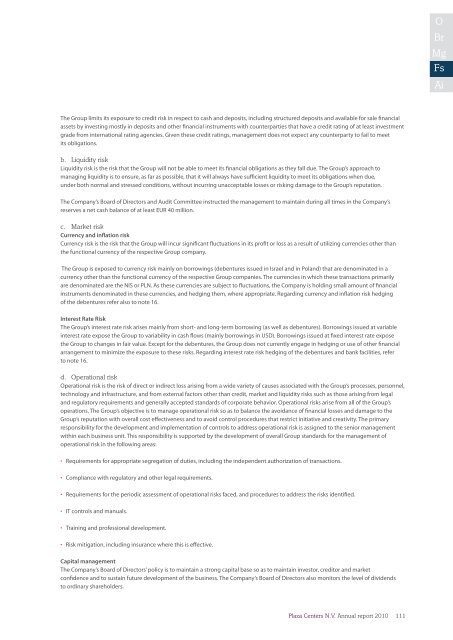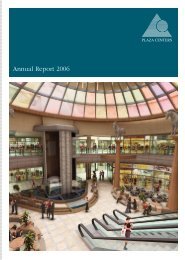Annual report 2010 - plazacenters
Annual report 2010 - plazacenters
Annual report 2010 - plazacenters
Create successful ePaper yourself
Turn your PDF publications into a flip-book with our unique Google optimized e-Paper software.
O<br />
Br<br />
Mg<br />
Fs<br />
Ai<br />
The Group limits its exposure to credit risk in respect to cash and deposits, including structured deposits and available for sale financial<br />
assets by investing mostly in deposits and other financial instruments with counterparties that have a credit rating of at least investment<br />
grade from international rating agencies. Given these credit ratings, management does not expect any counterparty to fail to meet<br />
its obligations.<br />
b. Liquidity risk<br />
Liquidity risk is the risk that the Group will not be able to meet its financial obligations as they fall due. The Group’s approach to<br />
managing liquidity is to ensure, as far as possible, that it will always have sufficient liquidity to meet its obligations when due,<br />
under both normal and stressed conditions, without incurring unacceptable losses or risking damage to the Group’s reputation.<br />
The Company’s Board of Directors and Audit Committee instructed the management to maintain during all times in the Company’s<br />
reserves a net cash balance of at least EUR 40 million.<br />
c. Market risk<br />
Currency and inflation risk<br />
Currency risk is the risk that the Group will incur significant fluctuations in its profit or loss as a result of utilizing currencies other than<br />
the functional currency of the respective Group company.<br />
The Group is exposed to currency risk mainly on borrowings (debentures issued in Israel and in Poland) that are denominated in a<br />
currency other than the functional currency of the respective Group companies. The currencies in which these transactions primarily<br />
are denominated are the NIS or PLN. As these currencies are subject to fluctuations, the Company is holding small amount of financial<br />
instruments denominated in these currencies, and hedging them, where appropriate. Regarding currency and inflation risk hedging<br />
of the debentures refer also to note 16.<br />
Interest Rate Risk<br />
The Group’s interest rate risk arises mainly from short- and long-term borrowing (as well as debentures). Borrowings issued at variable<br />
interest rate expose the Group to variability in cash flows (mainly borrowings in USD). Borrowings issued at fixed interest rate expose<br />
the Group to changes in fair value. Except for the debentures, the Group does not currently engage in hedging or use of other financial<br />
arrangement to minimize the exposure to these risks. Regarding interest rate risk hedging of the debentures and bank facilities, refer<br />
to note 16.<br />
d. Operational risk<br />
Operational risk is the risk of direct or indirect loss arising from a wide variety of causes associated with the Group’s processes, personnel,<br />
technology and infrastructure, and from external factors other than credit, market and liquidity risks such as those arising from legal<br />
and regulatory requirements and generally accepted standards of corporate behavior. Operational risks arise from all of the Group’s<br />
operations. The Group’s objective is to manage operational risk so as to balance the avoidance of financial losses and damage to the<br />
Group’s reputation with overall cost effectiveness and to avoid control procedures that restrict initiative and creativity. The primary<br />
responsibility for the development and implementation of controls to address operational risk is assigned to the senior management<br />
within each business unit. This responsibility is supported by the development of overall Group standards for the management of<br />
operational risk in the following areas:<br />
• Requirements for appropriate segregation of duties, including the independent authorization of transactions.<br />
• Compliance with regulatory and other legal requirements.<br />
• Requirements for the periodic assessment of operational risks faced, and procedures to address the risks identified.<br />
• IT controls and manuals.<br />
• Training and professional development.<br />
• Risk mitigation, including insurance where this is effective.<br />
Capital management<br />
The Company’s Board of Directors’ policy is to maintain a strong capital base so as to maintain investor, creditor and market<br />
confidence and to sustain future development of the business. The Company’s Board of Directors also monitors the level of dividends<br />
to ordinary shareholders.<br />
<br />
Plaza Centers N.V. <strong>Annual</strong> <strong>report</strong> <strong>2010</strong>111








